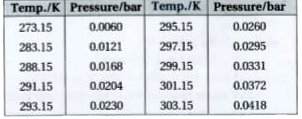Dalton.s law : The law was formulated by John Dalton in 1801. ..It states that the total pressure exerted by the mixture of non - reactive gases is equal to the sum of the partial pressures of individual gases...
i.e., the pressures which these gases would exert if they were enclosed separately in the same volume and under the same conditions of temperature.
Partial pressure (p) : In a mixture of gases, the pressure exerted by the individual gas is called .Partial pressure..
Mathematical formula of Dalton.s Law of partial pressure : Where `p_("Total")` is the total pressure exerted by the mixture of gas and `p_(1), p_(2), p_(3)` etc. are partial pressures of gases.
`p_("Total")=p_(1)+p_(2)+p_(3)+.....` (at constant T and V) ..... (Eq.-i)
Pressure of dry gas : Gases are generally collected over water and therefore are moist. So we have to obtained pressure of dry gas.
`(("Pressure of"),("Dry gas"))=(("Total pressure of"),("moist gas contains"),("water vapour"))-(("Vapour pressure"),("of water"))`
`therefore p_("Dry gas")=(p_("Total")-p_("Aqueous tension"))` ....(Eq.-ii)
Aqueous tension : Pressure exerted by saturated water vapour is called .aqueous tension.. Aqueous tension of water at different temperature is given in table.

Necessity to follow Dalton.s law : (i) Gases of Mixture are do not react with each other chemically (ii) Temperature and pressure of different gases remains same.
